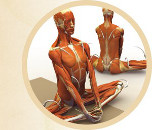


BOUND ANGLE POSE
Baddha konasana is a symmetrical pose. as such, it provides an opportunity for locating and balancing asymmetries, particularly in the hips and pelvis. First identify the elemental movements that create the form of the pose. For example, the hips flex, abduct, and externally rotate. Each component of hip movement is like a subplot in the story of the pose. Focusing on specific components brings greater awareness to the nuances of each movement. Begin with abduction: tight adductors can restrict drawing the knees apart. Use facilitated stretching, as detailed in the Key Concepts, to create length in the adductor group and free the hips to open the knees. Then work on improving external rotation of the hips. Limitations in this movement may stem from tightness in the internal rotators—the gluteus medius and minimus and the tensor fascia lata. Use the facilitated stretch provided for Padmasana (Lotus Pose) to increase the range of hip external rotation. Combine this with the mobility gained in abduction to deepen Baddha Konasana.
Next, invoke the deep external rotators of the hip and the muscles of the pelvic floor to nutate the sacrum and gain subtle depth in the pose. Connect the hands and feet. One variation has the elbows bending to draw the body forward. In another variation, the back arches and the shoulder blades draw together to lift the torso upward, expanding the chest. Use the arms in combination with the hamstrings to draw the feet closer to the pelvis—one objective of the final pose. Remember to maintain the knees as hinge joints. Gain most of your mobility from the hips, which are ball and socket joints.
BASIC JOINT POSITIONS

Bend the knees and take the general shape of the pose by flexing, abducting, and externally rotating the hips. Squeeze the lower legs against the thighs to activate the hamstrings. The hamstrings are muscular stabilizers of the knees; engaging them maintains congruency of the knee joint and helps to prevent excessive force being transmitted to the articular cartilage of the knee. Grasp the feet with the hands, and place the elbows into the crease between the upper and lower legs. Attempt to close (adduct) the knees to engage the adductor muscles in a facilitated stretch. Use a maximum of twenty percent of your force to draw the legs against the arms. Hold this action for a few slow, deep, and steady breaths. Then release the contraction and draw the knees closer to the floor by engaging the muscles at the sides of the hips—the gluteus medius and tensor fascia lata. This takes up the slack produced by the facilitated stretch and creates a new set length for the adductor muscles. Lengthen the internal rotators of the hips using the cradle stretch to increase external rotation. Repeat again as necessary to increase mobility of the hips. Carefully release the pose. Take Dandasana to contract and balance the muscles you have just stretched in Baddha Konasana— the adductors and internal rotators of the hips. This maintains the ha/tha or yin/ yang nature of yoga.
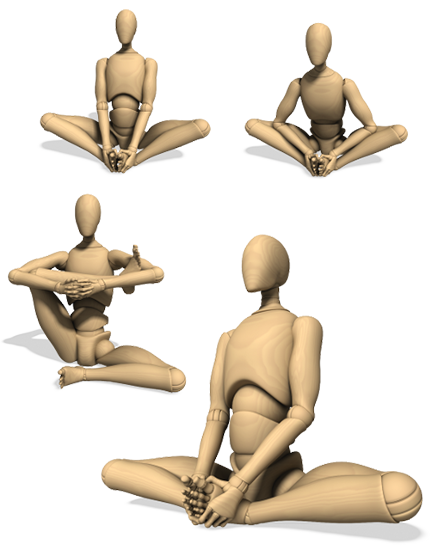

STEP 1 Flex the knees by engaging the hamstrings. Contracting the hamstrings not only bends the knees but also tucks the tailbone under, because the hamstrings originate from the ischial tuberosities on the back of the pelvis. Remember that the hips externally rotate in Baddha Konasana; tucking the tailbone under turns the hips outward and synergizes external rotation. The sartorius muscle runs from the front of the pelvis to the inner knee. It flexes, abducts, and externally rotates the hip. When contracted, the sartorius feels like a cord at the front of the pelvis. Its name derives from the Latin for “tailor,” because tailors used to sit cross-legged while they worked. Note that this muscle also crosses the knee and thus aids the hamstrings in flexing and stabilizing this joint in the pose.
Engage the psoas to flex and externally rotate the hips. A cue for this action is to press the hands on the knees and then attempt to draw them toward the body while resisting with the hands.
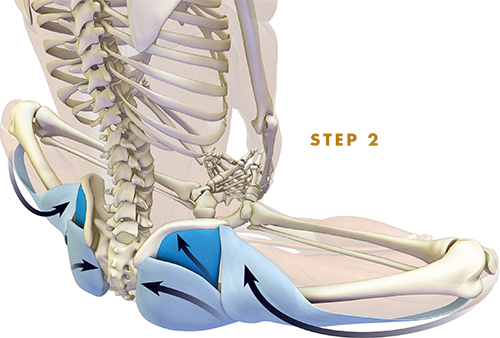
STEP 2 Squeeze the sides of the buttocks to abduct and externally rotate the hips, drawing the knees toward the floor. The gluteus maximus externally rotates the hips while the gluteus medius and tensor fascia lata abduct them. Activating these muscles stimulates reciprocal inhibition of the adductor group on the inner thighs, allowing them to relax into the stretch. You may note the paradox in contracting the gluteus medius and tensor fascia lata, since they also internally rotate the hips. In Baddha Konasana, the primary action of these muscles is to abduct the femurs. Certain fibers of these muscles must also be stretched to allow for the external rotation, as described in the preparation.
Note that when the hips are fully abducted, the contractile force of the tensor fascia lata and gluteus medius is far less, because these muscles are shortened almost completely. At this point it becomes necessary to engage the hamstrings and use the hands to draw the feet closer to the pelvis and the knees closer to the floor. The gluteus medius, tensor fascia lata, and gluteus maximus (the fibers that attach to the iliotibial band) act together to provide that extra inch of abduction in the pose. (The iliotibial band is a fibrous ribbon-like tendon that runs from the upper thigh to just below the knee. Both the tensor fascia lata and the gluteus maximus insert onto it. It abducts the hip and stabilizes the knee.)
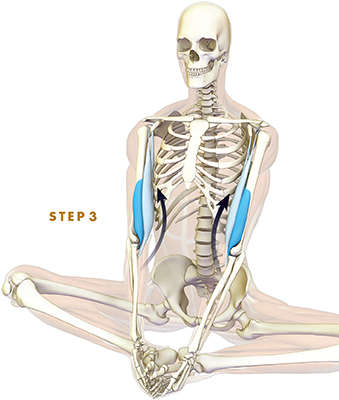
STEP 3 Flex the elbows by contracting the biceps and brachialis muscles. This draws the heels closer to the pelvis. Then engage the muscles described in Steps 4 and 5.
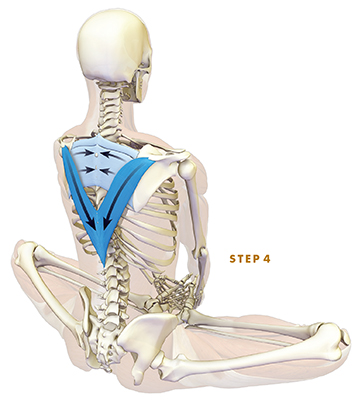
STEP 4 Draw the shoulders down the back with the lower trapezius and retract the shoulder blades toward the spine, using the rhomboids. Note how this expands the chest forward and, with the hands holding the feet, brings the heels closer to the pelvis. Combine this action with extending the back, as described in Step 5.
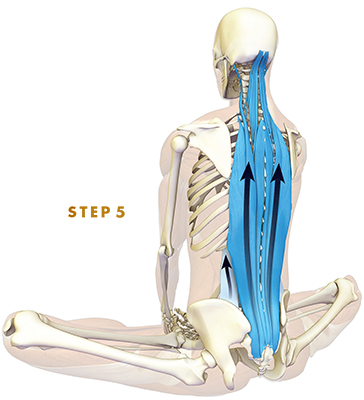
STEP 5 Activate the erector spinae and quadratus lumborum muscles to sit straight and tall. Engaging these muscles transmits a force to the hands, which hold the feet, and draws the feet closer to the pelvis, increasing the stretch of the adductor group on the inner thighs. Note that arching the lower back also tilts the pelvis forward, pulling on the hamstrings at their attachment on the sitting bones and drawing the lower legs in closer to the thighs.
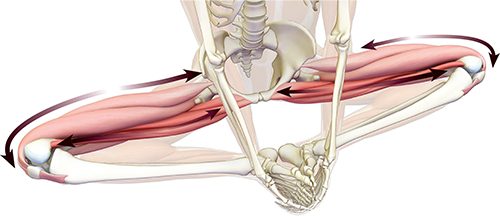
SUMMARY All of these interrelating subplots of the pose combine to stretch the adductor muscles on the inner thighs and the fibers of the gluteus medius, gluteus minimus, and tensor fascia lata that internally rotate the hips. Remember to balance this stretch by returning to Dandasana after the pose, and feel how practicing Baddha Konasana improves your Dandasana.